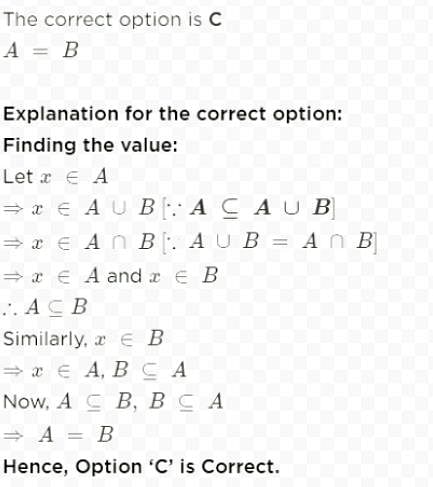Test: Set Theory- 1 - CAT MCQ
Test Description
10 Questions MCQ Test - Test: Set Theory- 1
Test: Set Theory- 1 for CAT 2024 is part of CAT preparation. The Test: Set Theory- 1 questions and answers have been prepared
according to the CAT exam syllabus.The Test: Set Theory- 1 MCQs are made for CAT 2024 Exam.
Find important definitions, questions, notes, meanings, examples, exercises, MCQs and online tests for Test: Set Theory- 1 below.
Solutions of Test: Set Theory- 1 questions in English are available as part of our course for CAT & Test: Set Theory- 1 solutions in
Hindi for CAT course.
Download more important topics, notes, lectures and mock test series for CAT Exam by signing up for free. Attempt Test: Set Theory- 1 | 10 questions in 10 minutes | Mock test for CAT preparation | Free important questions MCQ to study for CAT Exam | Download free PDF with solutions
Test: Set Theory- 1 - Question 1
Let R be a non-empty relation on a collection of sets defined by ARB if and only if A ∩ B = Ø
Then (pick the TRUE statement)
Then (pick the TRUE statement)
Detailed Solution for Test: Set Theory- 1 - Question 1
Detailed Solution for Test: Set Theory- 1 - Question 2
| 1 Crore+ students have signed up on EduRev. Have you? Download the App |
Detailed Solution for Test: Set Theory- 1 - Question 3
Detailed Solution for Test: Set Theory- 1 - Question 4
Detailed Solution for Test: Set Theory- 1 - Question 5
Test: Set Theory- 1 - Question 6
The number of elements in the Power set P(S) of the set S = {{1,2}, {2,3}, {2,4}} is given by
Detailed Solution for Test: Set Theory- 1 - Question 6
Detailed Solution for Test: Set Theory- 1 - Question 7
Test: Set Theory- 1 - Question 8
Let S be an infinite set and S1, S2, S3, ..., Sn be sets such that S1 ∪S2 ∪S3∪ .......Sn = S then
Detailed Solution for Test: Set Theory- 1 - Question 8
Detailed Solution for Test: Set Theory- 1 - Question 9
Detailed Solution for Test: Set Theory- 1 - Question 10
Information about Test: Set Theory- 1 Page
In this test you can find the Exam questions for Test: Set Theory- 1 solved & explained in the simplest way possible.
Besides giving Questions and answers for Test: Set Theory- 1, EduRev gives you an ample number of Online tests for practice
Download as PDF


 \
\














